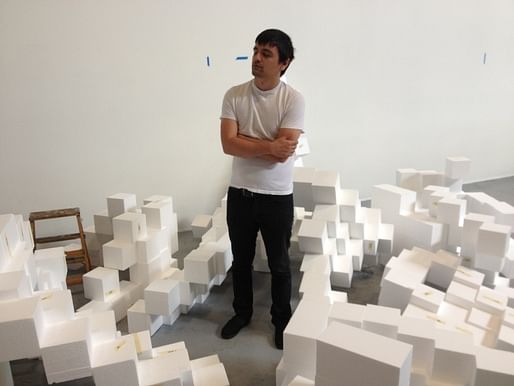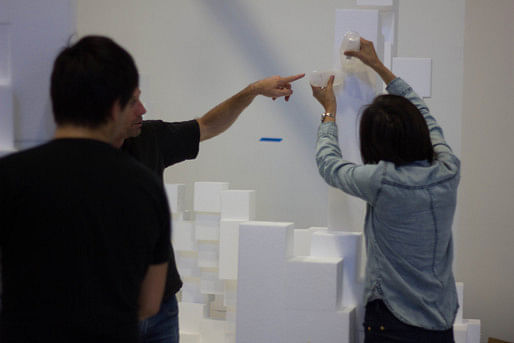

Last summer a small group of CCA graduate students assisted professor Thom Faulders in assembling a project called The Crystalline World: SUBHEDRAL, a collaboration with CCA professor Lynn Marie Kirby, for theElectronic Pacific exhibition at SOMArts. This provided an opportunity to speculate about the unique (and prosaic) aspects of installation construction. Is a project influenced by it’s diffuse method of assembly? And what kinds of micro-utopian characteristics arise in the making of a piece of art as opposed to it’s consumption?
Micro-utopias, or relational aesthetics, can be described as a participatory artistic process. It is an art that expresses itself in creating relationships between viewers, not with the piece. For The Crystalline World, the organizational structure was rhizomatic: each worker had input in the construction methodology. The only top-down (possibly even fascist) element of the project was our utter subservience to the 3D model. The assembly process began with a daunting number of 6″ x 6″ x 6″ foam cubes (with some 12″ and 18″ extrusions thrown in to keep us on our toes) which needed to be glued together into smaller chunks before the larger conglomerating could take place. This individualized work was akin to Steven Johnson’s “demons shouting up the chain” where smaller, dumber actors (my classmates and I) performed operations based on simple instructions—here, arranging cubes into strips of five or six according to full-scale printouts—that upper level demons would eventually coalesce into a larger demonstration, though this was not emergence in that there was clearly an overarching dictator: the Rhino model. This process doesn't differentiate itself from typical building construction where there is complete reliance on the construction documents but in this project’s type of labor workers didn't require any formal skills, though one person in every three person group did need to know how to take measurements of a Rhino model; not a low entry requirement. Similarly, in community built architectural projects there can be a large number of unskilled volunteers but there is still the necessity for people with construction know-how to organize, explain, and quality-check.

Could this project have been built any other way? Could state of the art technologies have streamlined this process, removing the communal qualities of it’s erection? Robots and drones would have been been unable to innovate in the gluing processes, as we had to many times, and on the fly. They also would not have been able to handle the manufacturing imperfections that had output cubes inexact by fractions of inches. It’s also hard to imagine the 3D printing process for this project. A large amount of support material would have been needed in all of the openings and an intense amount to print the roof. And depending on resolution, it’s hard to know how long current 3D printing technology would have taken to produce a project this size. The Huffington Post speculates that current household 3D printers would take 220 years to print an entire house. This would have put us past the project deadline, mos def.
No, in the end this project required humans and computers and machines to negotiate a productive truce. In the final assembly we had been placing so much faith in the 3D model that it felt sacrilegious to “throw it away” and force pieces together as we saw fit (pun totally intended). And perhaps it is this communal aspect, seen clearly in the finger prints, creases, and glue stains, that mark the charm of all artisanal efforts. Is it as easy to appreciate the quirks of computerized manufacturing processes? Will we one day marvel at the quaint imperfections of early 3D printed objects? Surely we don’t constantly marvel at the human craftsmanship that went into our modern homes? But once all of our built surroundings are put together by robots and printers and drones we will likely long for a human touch, some trace of aura, some imprint of the hands that pieced our world together.
(cover photo courtesy of Brendan Williams, others by me)

No Comments
Block this user
Are you sure you want to block this user and hide all related comments throughout the site?
Archinect
This is your first comment on Archinect. Your comment will be visible once approved.